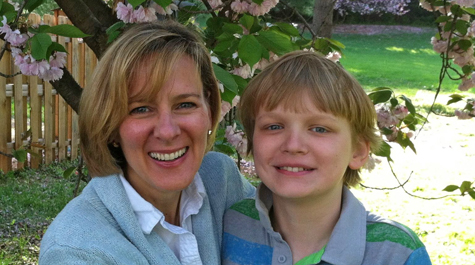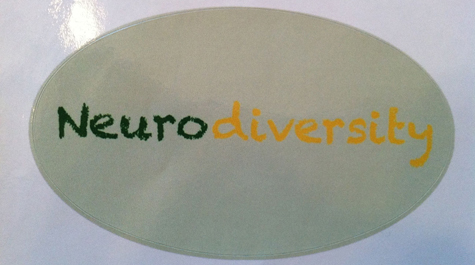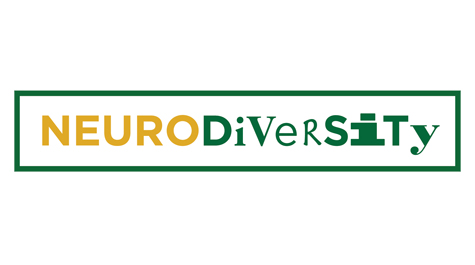Neurodiversity: Exploring, supporting a different way of thinking
Karin Wulf describes her 11-year-old son Ethan as an “amazing person” with knowledge and abilities beyond her own. He has a specialist’s knowledge of prehistoric mammals and passion for time travel. And when they watch movies together, he notices things that no one else does.
“He sees every frame, basically,” said Wulf, an associate professor of history and American studies. “God help the video editor who has made errors because Ethan will find them.”
Last year, on Ethan’s birthday, she wrote a Facebook post about why she was going to replace the light bulbs outside of her house with blue ones. It was part of the Light It Up Blue Campaign, an effort to increase awareness about autism, something that Ethan was diagnosed with when he was six years old.
Although Wulf said that writing publicly about Ethan’s diagnosis was a big step for her, she felt that it wasn’t enough.
“I just thought I should be doing something more,” she said.
That thought helped launch what is now the College of William and Mary’s Neurodiversity Working Group, a collection of faculty, staff, students, alumni, parents and community members who are working toward a better understanding and acceptance of brain differences – such as autism spectrum disorders – on campus.
The group, which began meeting in the fall, will kick off its programming efforts during Autism Awareness Month with a visit by John Elder Robison, an award-winning author who also happens to have Asperger’s Syndrome, a high-functioning form of autism. Robison will give a free public lecture on April 17 from 4 to 5:30 p.m. in Andrews Hall, Room 101.
‘Some people interact differently’
According to a recent report from the Centers for Disease Control, one in 88 children has been diagnosed with having an autism spectrum disorder, up from one in 110 as reported two years ago.
Around the country, a “first wave” of students with Asperger’s has been arriving on college campuses, according to Allison Gilmour of the Organization for Autism Research.
Those campuses include William & Mary, and though students are not required to self-identify as having an autism spectrum disorder, the members of the Neurodiversity Working Group know that they are out there and that there are likely faculty and staff members who are on the spectrum, too.
“Some people interact differently. We all know that,” said Wulf. “It’s just a matter of acknowledging that there is difference and that when we apply a standardized model, guess what, it doesn’t work so well.”
People on the spectrum can face an array of challenges as students on a college campus.
Renee Salas, a community member who is a part of the Neurodiversity Working Group, knows those challenges well as an autistic person and college graduate (Old Dominion University ’94) herself.
“The unpredictability of social interactions, less structured academic environments and close-quartered living arrangements with fellow students -- strangers, really -- are just a few of the overwhelming and at times unbearable issues for individuals on the autism spectrum,” she said. “The anxiety brought on by these aspects of college life are the very factors that can cause students to leave school prematurely, were they to choose to attend college at all.”
Many people on the spectrum try to fit into a “neurotypical” world “that is not truly suited for our needs,” said Salas, who also has two children on the spectrum.
“Colleges and universities cannot continue to allow these beautiful minds to go unnoticed, slipping through the cracks as if they don't matter or are too difficult to accommodate,” she said.
Education, awareness, support
Salas and the other members of the working group are hoping to prevent that from happening at William & Mary.
As a part of those efforts, one of the first things that they are doing is educating themselves, said Vice President for Student Affairs Ginger Ambler.
Ambler said she is always concerned with “making sure that every William & Mary student is able to be successful and to learn and thrive at William & Mary.”
“For a student who may be on the autism spectrum, that means we need to understand what their experience is like, and we need to know what their needs are so we can accommodate their needs just as we would for any other student, particularly a student who may have a disability,” she said.
At the counseling center, the clinicians are learning more about neurodiversity by working directly with students with Asperger’s who come in usually for the same reasons that other students do.
“We make our best effort to help students find their best way of being successful,” said Warrenetta Mann, director of the counseling center.
Wulf, too, is opening her door – literally – to people on campus with brain differences. She created a sticker to place on her door to indicate that her office is a safe place for people who think differently to talk to someone who “gets it.”
“I’m not an expert, just someone who appreciates (brain differences),” she said.
Already, Wulf has received requests from other faculty members – even some at other universities – for the sticker.
Another type of diversity
The group hopes to eventually increase the acceptance of brain differences on campus to the point that autism is just seen as another part of diversity, just as each student’s racial or ethnic background, religion and sexuality are.
“It’s another form or aspect of diversity that a person can bring to William & Mary,” said Chon Glover, assistant to the president for community initiatives and chief diversity officer. “The way in which a person thinks and carries out their life is a part of diversity, too.”
Mann said she would love to help William & Mary “be a place where all types of diversity are recognized and valued.”
“The things that make us unique allow us to find our special way of contributing to the community,” she said. “I know that we have students and faculty in our community that have something unique to offer either because they have high-functioning autism, or are interested in it. We have to raise awareness so that this people can fully express themselves.”
Although the group is just beginning its work, its members are excited about Robison’s visit and what else they may accomplish beyond that unofficial kick-off event.
“The fact that we have been able to get this initiative going so quickly attests to the type of place William & Mary is,” said Mann. “We are ready to lead in this area.”
No longer a deficit
In time, Salas hopes that other colleges and universities will begin similar programs on their campuses.
“It's not just the students of today who will benefit, but those of tomorrow as well,” she said. “And one day, in the not-so-distant future, it will be my kids and others like them that are served by such programs.”
As for Ethan, Wulf hopes that by the time he is old enough to think about going to college, the deficit model of autism – which focuses on the things that autistic people cannot do – “is a thing of the past.”
“I would never want to underestimate the challenges anyone with autism, including Ethan, faces,” she said. “My son struggles every day. But I hope we can move away from only thinking of autism as a deficit, appreciate difference, and see ability front and center. That's how I see Ethan.
“My son, he’s an amazing person.”

















